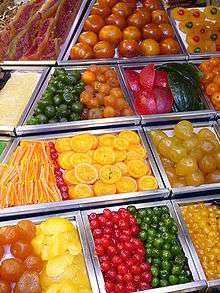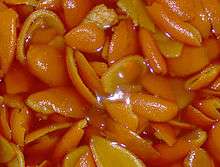Candied fruit
Candied fruit, also known as crystallized fruit or glacé fruit, has existed since the 14th century. Whole fruit, smaller pieces of fruit, or pieces of peel, are placed in heated sugar syrup, which absorbs the moisture from within the fruit and eventually preserves it. Depending on size and type of fruit, this process of preservation can take from several days to several months.[1] This process allows the fruit to retain its quality for a year.[2]
| Alternative names | crystallised fruit, glacé fruit |
|---|---|
| Type | Confectionery |
| Main ingredients | Fruit or peel, syrup |


The continual process of drenching the fruit in syrup causes the fruit to become saturated with sugar, preventing the growth of spoilage microorganisms due to the unfavourable osmotic pressure this creates.[3]
Fruits that are commonly candied include dates, cherries, pineapple, as well as a root, ginger.[4] The principal candied peels are orange and citron; these with candied lemon peel are the usual ingredients of mixed chopped peel (which may also include glacé cherries).
Recipes vary from region to region, but the general principle is to boil the fruit, steep it in increasingly strong sugar solutions for a number of weeks, and then dry off any remaining water.[5]
History
Food preservation methods using sugar (palm syrup and honey) were known to the ancient cultures of China and Mesopotamia. However, the precursors of modern candying were the Arabs, who served candied citrus and roses at the important moments of their banquets . With the Arab domination of parts of southern Europe, candied fruit made its way to the West. In Italy, they became a key ingredient of some of the most famous sweets of its culinary tradition: among these, the Milanese panettone and Cassata Siciliana.
Uses
Candied fruits such as cherries are commonly used in fruitcakes or pancakes.
See also
- Confit
- Maraschino cherry – Preserved, sweetened cherry
- Succade – Candied citrus peel
- Tanghulu – Skewers of glazed fruit (mainly hawthorn)
- Mostarda – Condiment from Italy made of candied fruit and mustard
References
- "Food, Facts, and Trivia — Candied Fruit". Retrieved 2007-11-22.
- "LA Times - Proper Storage Keeps Candied Fruit Fresh". Retrieved 2016-04-04.
- "Britannica Online Encyclopedia — Candied Fruit". Retrieved 2007-11-23.
- Answers.com (from The Food Lover's Companion) — candied fruit; candied flowers, with candied cherries being popularly referred to as "glacé cherries". Archived on 24 November 20091-06.
- Beckett-Young, Kathleen (1989-12-24). "FARE OF THE COUNTRY; Candied Fruit of Provence: Sweet Tradition". The New York Times. Retrieved 2010-04-28.